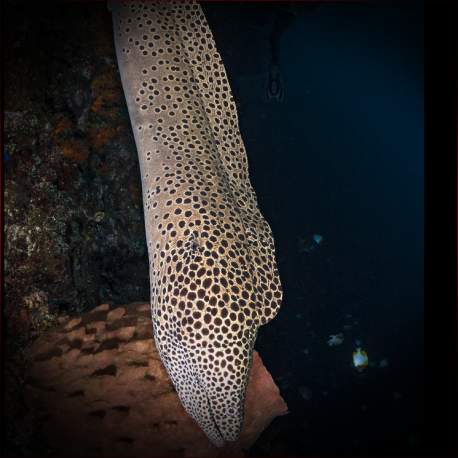More info
Datasheet
| Minimum Tank Size | 2000 litres / 528.34 US gallons |
| Maximum Size | 300.0cm / 118.11inches |
| Reef Compatible | Reef safe with caution |
| Temperament | Aggressive towards other species |
| Temperature | 22.2°C / 71.96°F - 25.6°C / 78.08°F |
| Specific Gravity | 1.020-1.025 |
| Carbonate Hardness | 8-12 |
| pH | 8.1-8.4 |
General Description
The Laced moray, scientifically known as Gymnothorax favagineus, is a species of moray eel belonging to the Muraenidae family. It can grow up to a substantial size of 300.0cm and is native to the Indo-Pacific region, including areas from the Red Sea and East Africa to Papua New Guinea, with a range extending from southern Japan to Australia.
Aquarium Suitability
Considered suitable for special aquariums, the Laced moray demands a very large tank, ideally around 2000 liters when fully grown. It is a hardy species but can be aggressive towards other fish, especially those that are peaceful or docile. Thus, it is crucial to provide plenty of hiding spots and ample space in the tank to mitigate aggressive behavior. Moreover, the Laced moray is an escape specialist, capable of moving loose lids and glass covers.
Care and Hardiness
This species of moray eel has a hardy nature, but it necessitates specific care requirements. It should be fed a large meal every 3-4 days to prevent overeating. Offering a varied diet of raw or fresh foods such as whole shrimps or small fish like smelt is essential. Additionally, it may take some time for them to adjust and start feeding in the aquarium, but live fish or shrimp can be considered if they initially reject frozen foods.
Reef Suitability
The Laced moray is classified as reef safe with caution, as it can potentially rearrange rocks and sand in the tank. While some moray eels are suitable for reef aquariums, larger species like the Gymnothorax favagineus require more substantial tanks with bigger fish companions.
Aquarium Setup
When setting up an aquarium for the Laced moray, it is crucial to provide secure hiding places, such as spots between live rocks, as they have a tendency to rearrange rocks and sand. Ensuring that rocks are securely placed on the substrate is vital to prevent toppling. Monitoring the tank for any potential escape routes is also necessary due to their exceptional ability to escape from aquaria.
Behaviour
The temperament of the Laced moray is notably aggressive towards other species, particularly those that are relatively large or small in comparison to its size. This species can pose a threat to larger fish and crustaceans within the tank, highlighting the importance of careful consideration when selecting tank mates.
Feeding and Diet
In terms of feeding, the Laced moray should be provided with a varied diet that includes fish, larger crustaceans like shrimp and crabs, and other invertebrates. Regular feeding every few days is crucial to maintain their health and prevent potential issues related to overeating.
Dimorphism
While information on dimorphism and captive reproduction is not provided in the available data, the focus remains on the unique care and behavioral aspects of the Laced moray.
Habitat and Distribution
The Laced moray, Gymnothorax favagineus, inhabits regions spanning from the Red Sea and East Africa to Papua New Guinea, with a distribution reaching from southern Japan to Australia. Its natural habitat includes the East Indian Ocean, West Indian Ocean, Australia, Japan, Indonesia, New Zealand, and the Central/West Pacific regions.

